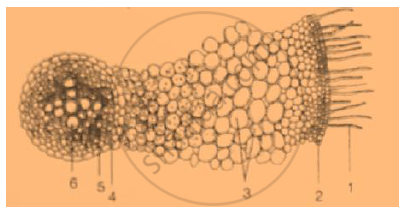Advertisements
Advertisements
प्रश्न
A thin strip of epidermal cells from the fleshy scales of an onion bulb was examined in a drop of water, under a microscope. All the epidermal cells looked alike and the figure alongside represents one of them. The thin strip was then transferred to a drop of strong sugar solution and re-examined under the microscope after about five minutes.

(i) Make a sketch of one of the epidermal cells, as it might appear after immersion in a strong sugar solution. Label any two parts which have undergone a change.
(ii) Give the scientific term for the change shown in Q.(i) above.
(iii) What would you do to bring this cell back to its original condition?
(iv) Give the scientific term used for the recovery of the cell as a result of the step taken in Q.(iii) above.
उत्तर
(i) See figure.

(ii) Plasmolysis.
(iii) We would immerse this cell into freshwater, i.e., hypotonic solution.
(iv) Deplasmolysis.
APPEARS IN
संबंधित प्रश्न
Differentiate between the following:
Guttation and bleeding
Given below is the diagrammatic representation of the transverse section of a part of a plant. Study it and answer the questions that follow:

(a) Name the part of the plant that is shown
(b) Label the parts 1 to 6
(c) Write the functions of parts 3 and 5
How is root hair adapted for the absorption of water from the soil?
Choose the correct answer:
The water is translocated upwards from the roots through _____________
The below figure shows a root hair:
(i) Label the parts 1 to 4.
(ii) What is the role of part 4?
(iii) Why is the root hair one-celled?
(iv) What will happen to the root hair if some fertilizer is added to the soil near the root hair?
Give Technical Term for the following.
Phenomenon of absorption of water by surface attraction.
Draw a neat and labelled diagram of the Root tip showing the root hair zone.
What would happen to the leaves of a plant that transpires more water than its absorption in the roots?
____________ regions are present in a typical root.
Epiphytic plants like orchids absorb water vapours from air with the help of ______ having special tissue called velamen.
